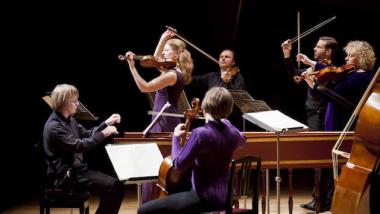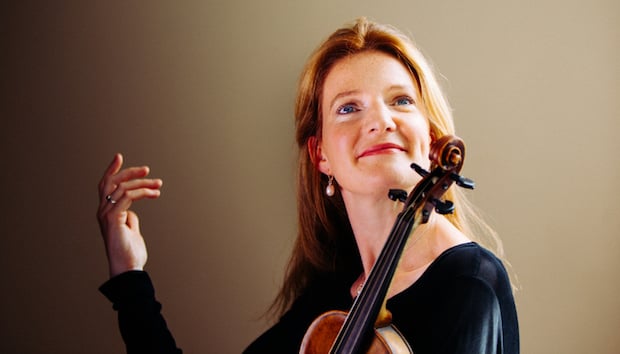
At 48, Baroque violinist Rachel Podger is at the top of her game. In the last two years alone, she has won BBC Music Magazine Awards for two different Channel Classics recordings: a solo effort, Guardian Angel, and one with her ensemble, Brecon Baroque, of Vivaldi’s L’Estro Armonico. She also received the Royal Academy of Music’s Bach Prize, and, most recently, Gramophone Magazine’s Baroque Instrumental Award for her recording of Biber’s Rosary Sonatas. All of these recordings are high-resolution, optional surround hybrid SACDs that convey her sound and expressive compass at their finest.
Nor does Great Britain have a monopoly on granting Rachel Podger awards. No stranger to the Bay Area, she recently won an SFCV Best of the Bay Award for her June Berkeley Festival & Exhibition performance of Bach and Vivaldi with Voices of Music. Now she returns to Philharmonia Baroque Orchestra, where she began performing in 2013, for her third appearance.
From looking at Rachel’s photos, it was clear that I would be speaking with an extremely gracious and delightful woman. Hence to Skype we went for an hour-long, laughter-punctuated chat about her imminent return to the Bay Area for November 2–6 performances of Veracini, Vivaldi, Bach, and Tartini with Philharmonia Baroque Orchestra.
You came of age when the early music movement was already established.
It was in full swing. I came into it at an amazing time, really, because I was able to benefit from all the information I had already been gathered about how to set up the instruments, and how to work with the strings and bows. It was incredible, really, to come into it that. Having grown up with early music, and having listened to historically informed performances, I guess I found it very natural to go to it and follow along.
I started playing the violin at 5. It was something I always wanted to do. Apparently, I’d always danced to violin music when I was a kid, and I remember that I could relate to it.
I remember on a kiddie’s television program there were all these Suzuki-method violin players. I was three or something, and I just pointed at them and said, ‘Mummy, I want to do that.’ So they got me an instrument, and I started learning the Suzuki method, which teaches far more by ear and memory than by visual.
My mother, who is 75, is German. We actually moved to Germany, and I had lessons there. Before I came back to England to study, I was already interested in historically informed performances, partly because, when I was 14, 15, 16, I sang in a choir where the conductor was really informed. We’d sing a lot of early Baroque music — Monteverdi, Carissimi, Bach, and madrigals — and he would get us to understand the harmony.
He explained it really, really well. He would get us to shape the long notes according to where the harmonic strengths were, which, of course, is the grammar of harmony. I didn’t have to think about it particularly later on, because it was a natural thing to do on the violin. Then, when I backed it up with the proper knowledge, I thought, ‘Oh, OK, so that’s why I’m doing that!’ I was very lucky to have been able to feed off all this knowledge and experience that was already around and available.
Were your parents musicians?
No. Actually, my father was an Anglican priest, and my mother worked with children and youth in the church. But they’re very musical. We often did family concerts at services: Christmas, Easter. Whatever I had just learned, my father asked me to play. It was a really good way to be relaxed about performing.
When did you make the switch from the modern violin to the Baroque violin?
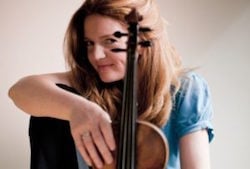
It happened once I went to the Guildhall School of Music and Drama in London. At that point, there were no undergraduate courses in Baroque music — only postgraduate. So I studied the regular violin. But there was an early music course going on there, so I opened the door to the room. I was a bit shy. It was mainly singers and lute players, taught by Nigel North and other teachers that I didn’t know at the time.
It was a different world. But there were no string players, which made me feel that I didn’t really belong. But then I got to know one of the recorder players, Pamela Thorby, who became a lifelong friend. She a beautiful player: incredibly musical and rhetorically really expressive. We played for a long time together in a group called The Palladium Ensemble.
I’ll never forget the first time I played with her, when she took me along to a lesson. I had this little Chinese Baroque violin, because I needed Baroque strings and a Baroque bow, which I didn’t have on my modern violin. The violin sounded like a cigar box. It was terrible. But the teacher, Philip Pickett, said to me, ‘You know, Rachel, this music is all about expression. You need to tell me something with this.’ You’re told this by other teachers as well. ‘Tell me a story ... let me know what’s going on.’ But the grammar was so different in early music. The articulations and the expressive means were all written into the music like a code. All you had to do was learn this code, and you’d know how to do it.
It seemed quite simple at the time. Only later did I realize that there are lots and lots of choices that you can make.
When I started out, I was very, very keen to be correct. That was my German side, from my mother. Also, I went to school in Germany, where I learned that it was very, very important to get everything right. And that’s a very good thing. I'm not knocking it at all.
But in terms of how to express an emotion and understand what the composer is after, you need to have lived a little bit. It’s tricky to do that when you’re 15 or 16. Of course, some geniuses can do that at the age of 3. Sometimes you see these clips of Japanese or Chinese pianists at 5. They play Schubert, and it’s as though they’re 95. They seem to have a whole life in there! It makes you wonder, doesn’t it?
In switching to Baroque repertoire, what spoke to you and continues to speak to you?
The main thing is that it’s very direct music. A lot of it feels very spoken, as though you’re actually speaking or singing to the audience. For me, a lot of it is about communication. You feed off the communication with the other players, very much so — I’m really, really into that — and then you sense the reaction from the audience, and you feed off that too. That’s kind of magic. It’s that magic thing going on.
I guess you could have that with any repertoire. But it has something to do with the structure of Baroque pieces. Baroque phrases are overseeable — they don’t go on forever and ever. You have a very clear structure. To impart that the best, you need a freshness, and you need to be direct about it. That’s what makes the music special and approachable.
If you play kids some Vivaldi, they go ‘Whee!’ and just jump up and down. It’s popular stuff in that way. Then you play the slow movement and they start dreaming. It’s very wonderful. I think about that a lot, how kids react. We all have a kid inside us. If you can reawaken that in the audience, it’s really nice.

How much of the ornamentation and fanciful flights in the music you’re playing with PBO is written down?
We’re doing an overture by Veracini that he wrote for the orchestra in Dresden. It is quite a virtuosic piece — the strings have quite a lot to do — and it also uses two oboes, bassoon, and strings. Verracini was an amazing violinist — a very proud violinist — and very able, who wrote loads for the violin. Harmonically it’s not as interesting as it might be — it’s pretty standard harmonies and things — but there are some beautiful sequences, and it’s really fiery and full of character.
That piece has a lot of ornamentation written out. So we won’t be adding many notes apart from trills at cadences.
Of course, the idea of ornamentation is very much a kind of solo thing. When I play the Vivaldi D major and Tartini A major violin concertos, it is very much the practice to add as much as you want. But it needs to be in keeping with the mood and character of the piece, and what else is going on. If someone else has the tune, you don’t cover it up with ketchup. You need to respect what other people are doing. In other words, it needs to be tasteful.
Composers really varied in how they imagined their music, how they wanted their music portrayed, and how they let people be free. I think of Couperin, who is incredibly bossy. He writes every tiny little ornament, and says in his preface, ‘No one is allowed to add a thing.’
What about Vivaldi and Tartini? Do we have scores that musicians of the time used that show what they did?
Yeah. We certainly do, which is really, really useful. The whole of the Opus 5 sonatas by Corelli, who was the father of Italian violin playing — Vivaldi would have fed off him — includes ornamentations that people would have been used to playing. We don’t know if they’re by him or by someone else, but they are written down.
In the slow movements of the sonatas, you’ll get the simple line and then you’ll get the ornamented line above it. It’s like art. It’s got loads of curves and beautiful florid lines that look like flamenco, although I don’t know why I'm mentioning flamenco.
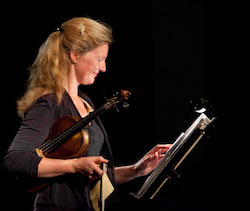
There are lots of tables, particularly in Tartini, where he writes down even one phrase of a slow movement, and then gives you loads and loads of examples of how to ornament it. It’s fantastic. And they get more and more complicated, and really difficult to decipher. I have one that is so tiny that you almost need a microscope. It’s very hard to work out exactly how it should go.
If you look at Bach’s violin music, or any of his preludes for keyboard or other instruments, they are full of written out ornamentation. It shows you the kind of thing that players were doing.
Improvisation and extemporization were very much part of playing. You’d get your fiddle out — you wouldn’t get the music — and just start playing like folk musicians. You’d have some tune in your head, and start playing it, and then vary it. Each time you’d do it differently. It’s like jokes. They always get longer, don’t they? If you tell them over and over again, you add a little bit and make it more interesting because you don’t want to say the same thing over and over.
You put the program together with Nic (Nicholas McGegan). Is there any particular theme or place you want to take people?
We definitely wanted to have some Bach. For me, personally, it doesn’t get much better than Bach. And we wanted to involve some wind instruments, such as oboe and bassoon, that were missing from my last few all-string programs.
I thought of the Bach First Suite, with some beautiful bits and episodes for the winds. I love that suite. It has a chamber feeling, and works well without a conductor. The other suites have drums, trumpets and lots going on, and are not as easy without a conductor. I haven’t been trained to lead an orchestra without an instrument. You need to know what you’re meant to do with your hands. I guess naturally certain thing happens that I’d want to know exactly to bring out the best in people. I think I’d feel really naked without an instrument.
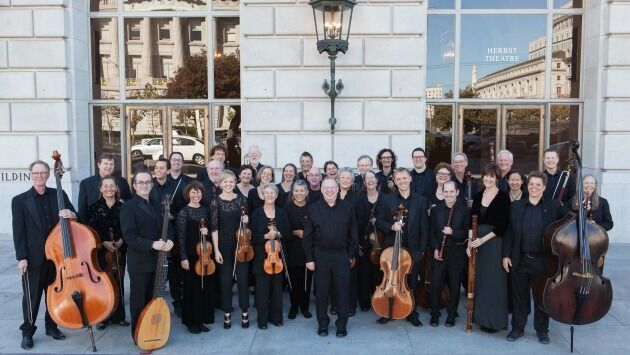
From your performances with PBO and Voices of Music, you’ve become a legend of sorts in the Bay Area. What does it feel like to return?
When I played with them in the Early Music Festival in Berkeley in June, I knew most of the players from Philharmonia Baroque. Everyone is very open minded and really keen to make good music, and very focused. The energy is very high. You talk about something, and people say, ‘Yeah, yeah, let’s do it.’ They’re more open than some groups I’ve worked with. And the audience always seems out for a good time.
It’s always a lovely atmosphere. You come on, and people are smiling because they know you from before.
I’m really looking forward to this concert. You have an intense time with the orchestra, and then you go away and do all sorts of other things in other places. Then you come back, and it’s as though you never left. That’s really amazing. People are very fresh and lovely, and so very welcoming.

